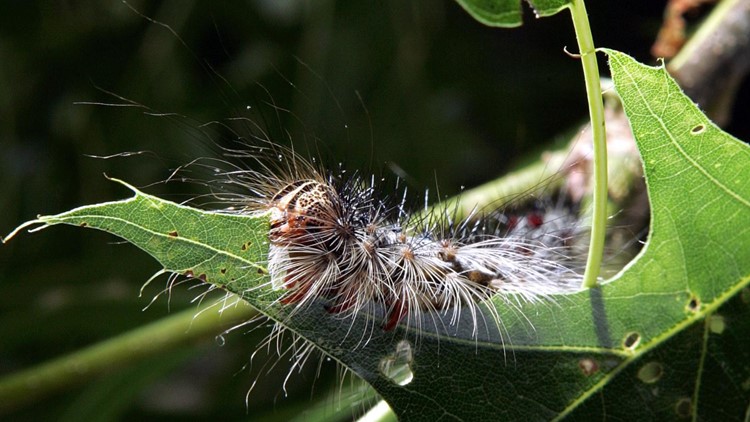HARRISBURG, Pa. — The Department of Conservation and Natural Resources announced Monday the start of aerial spraying of state woodlands to combat spongy moths (Lymantria dispar dispar, formerly known as the gypsy moth) populations poised for spring outbreaks in many sections of Pennsylvania.
“Suppression efforts are underway as the caterpillars emerged and begun feeding,” said DCNR Secretary Cindy Adams Dunn. “Aerial suppression is needed to keep this invasive pest in check and protect our native forests from defoliation, with oaks being one of its favorite host. Keeping our forests healthy is of paramount importance, to protect all of the values our forests provide, including recreation, habitat, timber, clean air and clean water.”
The suppression program aims to minimize defoliation so that trees do not become stressed and succumb to disease, other insect pests, or drought.
Aerial spraying will be conducted by two helicopters and six fixed-wing aircraft..
The DCNR Spongy Moth Daily Spraying Status GIS Map shows the location of all 185 spray blocks, allowing users to follow the treatment program's progress.
In 2023, spongy moth defoliated 441,819 acres in Pennsylvania.
DCNR’s Bureau of Forestry will oversee spraying of 185 sites totaling 227,820 acres.
Included will be portions of 12 state forests and 18 state parks, and one federal property in 20 counties located in southcentral, central, northcentral, and northeast Pennsylvania.
In 2023, a total of 290,000 acres were treated.
In addition to DCNR’s spray program, the Pennsylvania Game Commission will also be conducting an aerial spray program in 2024 on approximately 124,000 acres of State Game Lands.
State parks to be sprayed include:
- Bald Eagle, Centre County
- Big Spring, Perry County
- Colonel Denning, Cumberland County
- Colton Point, Tioga County
- Hyner View, Clinton County
- Kings Gap, Cumberland
- Leonard Harrison, Tioga County
- Little Pine, Lycoming County
- Ole Bull, Potter County
- Penn Roosevelt, Centre County
- Poe Paddy, Centre County
- Poe Valley, Centre County
- Prince Gallitzin, Cambria County
- R.B. Winter, Union County
- Ravensburg, Clinton County
- Reeds Gap, Mifflin County
- Sand Bridge, Union County
- Whipple Dam, Huntingdon County
Federal property to be sprayed include:
- Grey Towers National Historic Site, Pike County
“These destructive, invasive insects go through cycles where outbreaks generally occur every 5 to 10 years,” DCNR Forest Health Manager Rosa Yoo said. “We are entering our fourth year of the outbreak cycle, and egg mass surveys from last year determined the need for suppression efforts again this year. The good news is that we observed a decline in spongy moth defoliation from 850,000 acres in 2022 to 440,000 acres in 2023, signifying a decline in spongy moth populations and the importance of these suppression activities to help continue to reduce spongy moth populations.”
Targeted sites are determined by surveys of egg masses and other indicators across the state indicating high population levels that have the potential to cause major defoliation.
Tips for homeowners with spongy moth infestations:
Survey your property for egg masses in the summer and fall.
The spongy moth has one generation per year in Pennsylvania.
Females lay their eggs as light tan egg masses (100-1,500 eggs/mass) on trees, stones, and other substrates during June and July.
Eggs hatch from mid-April to early May the following spring.
Penn State Extension offers a Guide to Spongy Moth Egg Mass SurveyingOpens In A New Window, which includes an instructional video, both of which explain how to survey for spongy moth egg masses.
Spongy Moth impact:
Feeding while in the larval, or caterpillar, stage, the insect usually hatches and begins feeding from mid-to-late April in southern Pennsylvania and in early to mid-May in the northern part of the state.
Oak, apple, sweet gum, basswood, birch, aspen, and willow trees are most affected by the spongy moth.
DCNR Bureau of Forestry experts note the state’s oak stands are especially vulnerable to infestations.
A tree begins to significantly suffer when 30 percent or more of its leaf surface is lost, and when left untreated, heavy infestations over two to three consecutive years can result in tree mortality.
Oak mortality leads to a loss of timber resources, a decrease in the carbon sequestered by our forests, and a negative impact on the habitat quality of many of our native species.
Not only are oaks an important mast species for wildlife, but oaks host a significant number of native insects and invertebrates as well.
Which insecticides are used?
The applied insecticides, tebufenozide or Bacillus thuringiensis subsp. kurstaki, must be ingested by young caterpillars as they feed on emerging foliage.
These products are subject to State and Federal environmental review and are deemed safe for use, and are commonly used in agriculture.
Begun in 1972, the forest insect spray program is a cooperative effort between the DCNR and the U.S.D.A. Forest Service’s Forest Health Protection Unit.
Where did spongy moths come from?
The spongy moth was introduced to North America in 1869 at Medford, Massachusetts, where it was used in a failed silk-production experiment.
The spongy moth first reached Pennsylvania in Luzerne County in 1932 and, since then, has infested every county.
Visit DCNR’s website for more information about spongy moths and DCNR’s suppression program.



